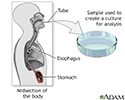Gastric tissue biopsy and culture
Culture - gastric tissue; Culture - stomach tissue; Biopsy - gastric tissue; Biopsy - stomach tissue; Upper endoscopy - gastric tissue biopsy; EGD - gastric tissue biopsyGastric tissue biopsy is the removal of stomach tissue for examination. A culture is a laboratory test that examines the tissue sample for bacteria and other organisms that can cause disease.
Biopsy
A biopsy is the removal of a small piece of tissue for lab examination.

How the Test is Performed
The tissue sample is removed during a procedure called upper endoscopy (or EGD). It is done with a flexible tube with a small camera (flexible endoscope) at the end. The scope is inserted down the throat into the stomach.
Upper endoscopy (or EGD)
Esophagogastroduodenoscopy (EGD) is a test to examine the lining of the esophagus, stomach, and first part of the small intestine (the duodenum)....

Your health care provider sends the tissue sample to a laboratory where it is examined for signs of cancer, certain infections, or other problems.
How to Prepare for the Test
Follow instructions on how to prepare for the procedure. You will likely be asked not to eat or drink anything for 6 to 12 hours before the procedure.
How the Test will Feel
Your provider will tell you what to expect during the procedure.
Why the Test is Performed
This test may be done to diagnose a stomach ulcer or the cause of other stomach symptoms. These symptoms may include:
Stomach ulcer
A peptic ulcer is an open sore or raw area in the lining of the stomach (gastric ulcer) or in the first part of the small intestine (duodenal ulcer)....

- Loss of appetite or weight loss
- Nausea and vomiting
- Pain in the upper part of the belly
- Black stools
- Vomiting blood or coffee ground-like material
A gastric tissue biopsy and culture can help detect:
- Cancer
- Infections, most commonly Helicobacter pylori, the bacteria that can cause stomach or intestinal ulcers
Helicobacter pylori
Helicobacter pylori (H pylori) is a type of bacteria that infects the stomach. It is very common, affecting about two thirds of the world's populati...
 ImageRead Article Now Book Mark Article
ImageRead Article Now Book Mark Article
Normal Results
A gastric tissue biopsy is normal if it does not show cancer, other damage to the lining of the stomach, or signs of organisms that cause infection.
A gastric tissue culture may be considered normal if it does not show certain bacteria. Stomach acids normally prevent too much bacteria from growing.
What Abnormal Results Mean
Abnormal results may be due to:
-
Stomach (gastric) cancer
Stomach (gastric) cancer
Stomach cancer is cancer that starts in the stomach.
 ImageRead Article Now Book Mark Article
ImageRead Article Now Book Mark Article -
Gastritis, when the lining of the stomach becomes inflamed or swollen
Gastritis
Gastritis occurs when the lining of the stomach becomes inflamed or swollen. Gastritis may last for only a short time (acute gastritis) or it may lin...
 ImageRead Article Now Book Mark Article
ImageRead Article Now Book Mark Article - Helicobacter pylori infection
Risks
Your provider will discuss the risks of the upper endoscopy procedure with you.
References
Feldman M, Jensen PJ, Howden CW. Gastritis and gastropathy. In: Feldman M, Friedman LS, Brandt LJ, eds. Sleisenger & Fordtran's Gastrointestinal and Liver Disease. 11th ed. Philadelphia, PA: Elsevier; 2021:chap 52.
Sugumar A, Vargo JJ. Preparation for and complications of GI endoscopy. In: Feldman M, Friedman LS, Brandt LJ, eds. Sleisenger & Fordtran's Gastrointestinal and Liver Disease. 11th ed. Philadelphia, PA: Elsevier; 2021:chap 42.
-
Culture of gastric tissue biopsy - illustration
A flexible fiberoptic tube is passed through the mouth and down the esophagus until it enters the stomach. The tube allows the health care provider to see the various parts and take a biopsy (sample). The sample is taken to the laboratory to be examined. The procedure is used to determine the cause of bleeding, and to diagnose tumors, ulcers, inflammatory disease, and structural abnormalities of the stomach.
Culture of gastric tissue biopsy
illustration
-
Esophagogastroduodenoscopy (EGD) - illustration
Esophagogastroduodenoscopy (EGD) is a test procedure to examine the lining of the esophagus, stomach, and first part of the small intestine. The procedure uses an endoscope. This is a flexible tube with a light and camera at the end. A biopsy can be taken through the endoscope of any suspicious areas that are seen.
Esophagogastroduodenoscopy (EGD)
illustration
-
Culture of gastric tissue biopsy - illustration
A flexible fiberoptic tube is passed through the mouth and down the esophagus until it enters the stomach. The tube allows the health care provider to see the various parts and take a biopsy (sample). The sample is taken to the laboratory to be examined. The procedure is used to determine the cause of bleeding, and to diagnose tumors, ulcers, inflammatory disease, and structural abnormalities of the stomach.
Culture of gastric tissue biopsy
illustration
-
Esophagogastroduodenoscopy (EGD) - illustration
Esophagogastroduodenoscopy (EGD) is a test procedure to examine the lining of the esophagus, stomach, and first part of the small intestine. The procedure uses an endoscope. This is a flexible tube with a light and camera at the end. A biopsy can be taken through the endoscope of any suspicious areas that are seen.
Esophagogastroduodenoscopy (EGD)
illustration
Review Date: 10/13/2023
Reviewed By: Linda J. Vorvick, MD, Clinical Professor, Department of Family Medicine, UW Medicine, School of Medicine, University of Washington, Seattle, WA. Also reviewed by David C. Dugdale, MD, Medical Director, Brenda Conaway, Editorial Director, and the A.D.A.M. Editorial team.



